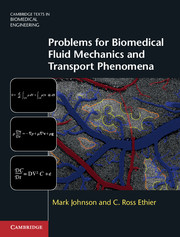Book contents
- Frontmatter
- Dedication
- Contents
- Preface
- 1 Problem solving
- 2 Conservation of mass and theReynolds transport theorem
- 3 Steady and unsteadyBernoulli equation and momentum conservation
- 4 Viscous flow
- 5 Momentum boundary layers
- 6 Piping systems, frictionfactors, and drag coefficients
- 7 Problems involving surface tension
- 8 Non-Newtonian blood flow
- 9 Dimensional analysis
- 10 Statistical mechanics
- 11 Steady diffusion and conduction
- 12 Unsteady diffusion and conduction
- 13 Convection of mass and heat
- 14 Concentration and thermal boundarylayers
- 15 Mass and heat transfer coefficients
- 16 Osmotic pressure
- Appendix A Material properties of fluids
- Appendix B Transport equations
- Appendix C Charts
- References
- Permissions
4 - Viscous flow
(33 problems)
Published online by Cambridge University Press: 18 December 2013
- Frontmatter
- Dedication
- Contents
- Preface
- 1 Problem solving
- 2 Conservation of mass and theReynolds transport theorem
- 3 Steady and unsteadyBernoulli equation and momentum conservation
- 4 Viscous flow
- 5 Momentum boundary layers
- 6 Piping systems, frictionfactors, and drag coefficients
- 7 Problems involving surface tension
- 8 Non-Newtonian blood flow
- 9 Dimensional analysis
- 10 Statistical mechanics
- 11 Steady diffusion and conduction
- 12 Unsteady diffusion and conduction
- 13 Convection of mass and heat
- 14 Concentration and thermal boundarylayers
- 15 Mass and heat transfer coefficients
- 16 Osmotic pressure
- Appendix A Material properties of fluids
- Appendix B Transport equations
- Appendix C Charts
- References
- Permissions
Summary
When blood is taken out of the body for processing into an extracorporeal device, a major concern is that the level of shear stress to which the blood is exposed should be less than a critical level (roughly 1000 dyne/cm2). For exposure to shear-stress levels higher than this, lysis of the red blood cells can occur, together with platelet activation and initiation of the clotting process.
Consider the flow of blood through a device that has a set of parallel tubes each with a diameter of 1 mm and a length of 10 cm. What is the maximum pressure drop that should be used for such a device if the highest shear levels in the device occur in these tubes? (Blood has a viscosity about five times that of water.) You may neglect entry effects and treat the flow as fully developed.
A parallel-plate flow chamber is to be designed to study the effects of shear stress on adhesion of leukocytes to endothelia. However, endothelial cells can be damaged by shear stress greater than 400 dyne/cm2. The width of the flow channel is to be 1 cm and its length 5 cm. The flow is to be driven by gravity, and a fluid column 1 m in height is available. The system must work both for saline and for blood. What should be the maximum separation (s ≪ 1 cm) between the two plates such that the endothelial cells are not damaged? The schematic diagram below is not to scale. You may neglect entry effects and treat the flow as fully developed.
- Type
- Chapter
- Information
- Publisher: Cambridge University PressPrint publication year: 2013



